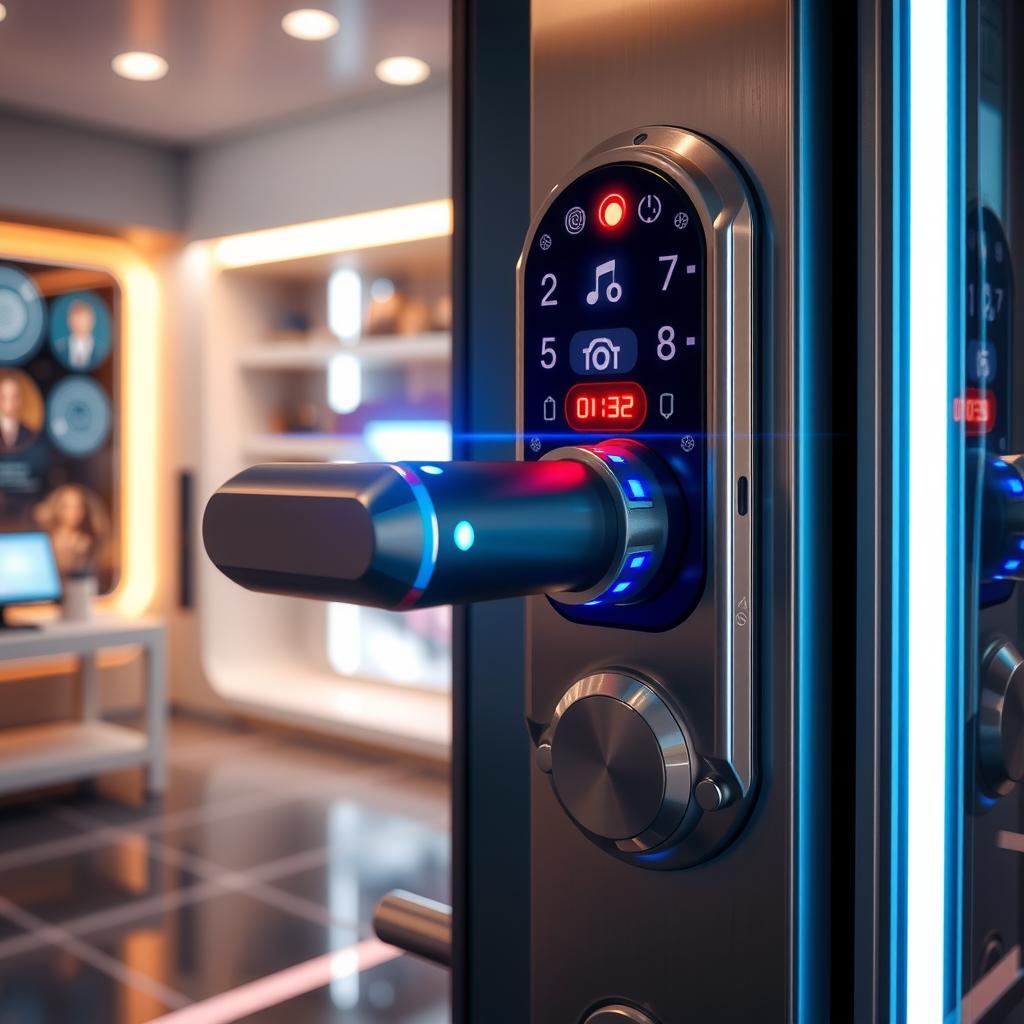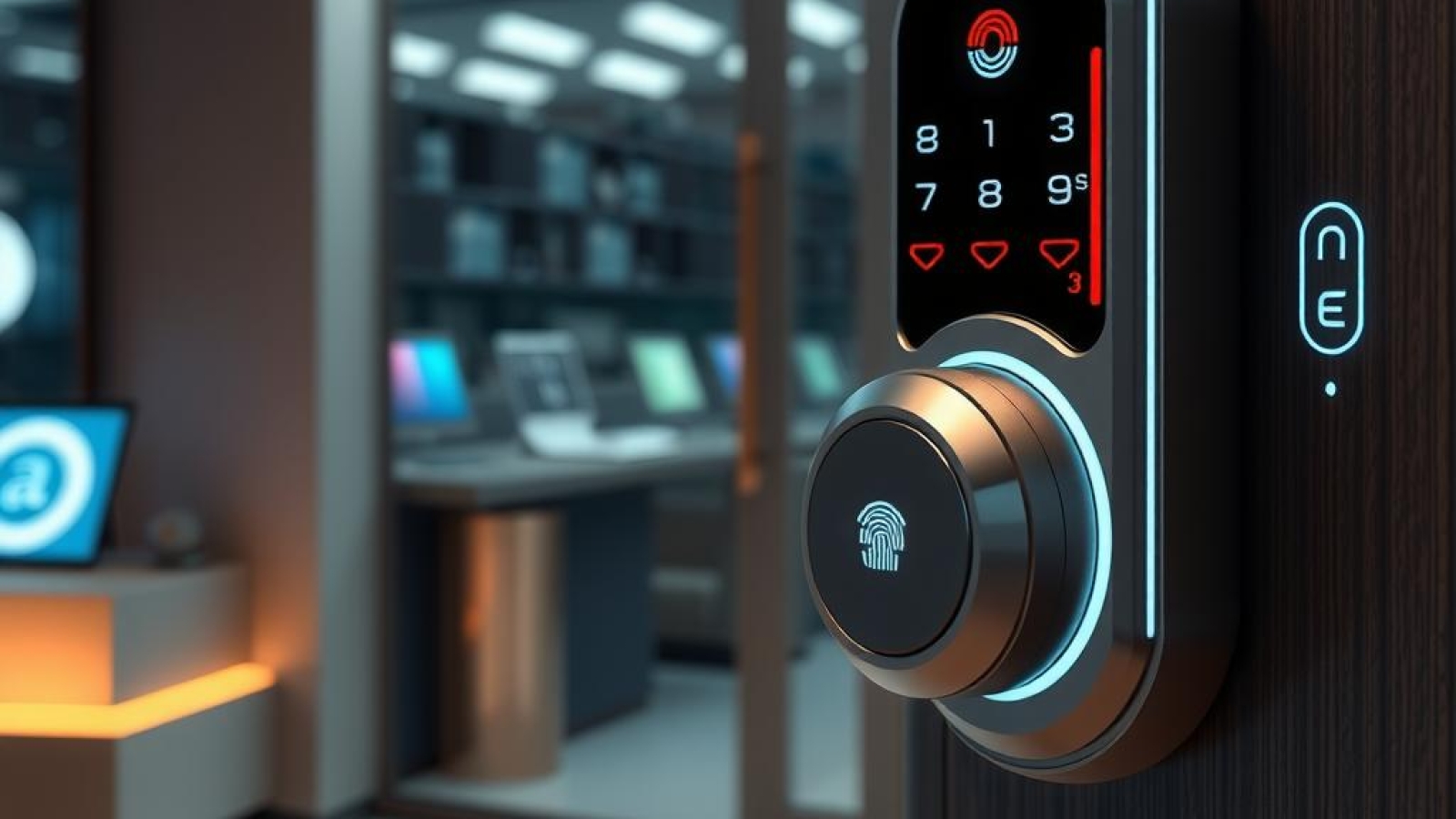In an era where digital security breaches and unauthorized access are at an all-time high, ensuring the safety of one’s home has never been more critical. Traditional locking mechanisms no longer suffice in protecting valuable assets from potential threats. Enter multi-factor authentication systems for smart locks—a revolutionary approach that combines convenience with unparalleled security measures. These systems not only enhance user verification processes but also empower homeowners to take control of their own identity protection through advanced technology.
The core value of integrating multi-factor authentication into smart lock designs lies in its ability to provide a layered defense against intruders. By requiring two or more verification forms—such as something you know (a password), something you have (a smartphone app), or something you are (biometric data)—these innovative security systems significantly reduce the likelihood of unauthorized access. As users navigate the complexities of modern life, they seek solutions that offer both efficiency and peace of mind; this is where multi-factor authentication shines.
Moreover, these sophisticated authentication systems cater to a diverse range of needs—from remote access capabilities allowing users to monitor their property on-the-go, to customized entry codes for family members and trusted visitors. The integration of such features ensures that homeowners remain connected while maintaining robust access control over who enters their space and when.
As we delve deeper into the world of multi-factor authentication within smart locks, this article will explore how these technologies work in tandem with existing security frameworks, highlighting real-world applications and benefits for everyday consumers. By leveraging cutting-edge advancements in digital security, individuals can fortify their homes against evolving threats—all while enjoying seamless accessibility like never before. Join us on this journey towards understanding how multi-factor authentication can transform your perception of home security today!

Key Takeaways:
-
Key Takeaway: Enhanced Security Through Layered Verification
The integration of multi-factor authentication systems with smart locks significantly strengthens security measures. By requiring various forms of user verification—such as biometric scans or one-time codes—this approach minimizes the risk of unauthorized access, ensuring that only verified individuals can gain entry to personal spaces. -
Key Takeaway: Remote Access Control for Peace of Mind
As digital connectivity increases, the ability to maintain control over access control from afar is crucial. Using multi-factor authentication systems, individuals can monitor and manage who enters their home or business remotely, providing reassurance that they remain in charge of their security even when they are not physically present. -
Key Takeaway: User Convenience Meets Robust Identity Protection
While enhancing safety is vital, user convenience should not be overlooked. The incorporation of multi-factor authentication systems into existing security systems allows for a seamless experience without compromising protection. This balance ensures that homeowners and businesses benefit from advanced identity protection while enjoying easy access to their premises.

Understanding Multi-Factor Authentication in Smart Locks
Multi-factor authentication (MFA) has emerged as a critical component in the realm of digital security, particularly when applied to smart locks and sophisticated access control systems. By requiring users to provide multiple forms of verification before granting access, these multi-factor authentication systems significantly enhance the security posture of residential and commercial properties alike. The significance of MFA lies not only in its ability to protect against unauthorized entry but also in its role as an essential barrier against the growing threats posed by cybercriminals. With traditional password-only protection proving increasingly inadequate, integrating multi-factor authentication offers a robust solution for user verification that can deter potential breaches effectively.
Smart locks equipped with multi-factor authentication offer various methods for identity protection; these may include something the user knows (like a password), something they possess (such as a smartphone), or even biometric data like fingerprints. This layered approach ensures that if one form of identification is compromised, others still safeguard access. For instance, when using remote access features on smart locks — which allow homeowners to manage their locking systems via mobile applications — multi-factor authentication provides an added layer of defense against hacking attempts.
The implementation of multi-factor authentication systems within smart lock technology exemplifies how modern security solutions are evolving to meet escalating demands for safety and convenience. As users become more reliant on digital platforms for everyday tasks, ensuring secure interactions becomes paramount; this includes managing entry points into physical spaces through advanced locking mechanisms. Moreover, utilizing MFA not only protects assets but also instills confidence among users regarding their identity protection measures.
Incorporating multi-factor authentication into existing security frameworks can significantly improve overall system integrity while addressing vulnerabilities associated with single-layered protections such as passwords alone. Security experts recommend this strategy as it directly correlates with reduced incidents involving unauthorized access attempts on both personal and organizational levels.
Thus, understanding and embracing multi-factor authentication is crucial for anyone considering installing smart locks or enhancing their current security arrangements. By prioritizing multifaceted user verification processes over traditional methods, property owners can better shield themselves from emerging threats in today’s interconnected world while enjoying peace of mind regarding their safety protocols.
Enhancing Home Security with Advanced Access Control
Exploring Seamless Integration of Multi-Factor Authentication and Smart Locks
In the contemporary landscape of home security, integrating multi-factor authentication systems with smart locks represents a significant advancement in user verification processes. This integration not only fortifies access control but also simplifies daily routines for homeowners. By requiring multiple forms of identification—such as a unique passcode paired with biometric recognition or an authentication app—these systems ensure that unauthorized individuals are effectively kept at bay. For instance, when coupled with smart locks, which allow remote access via smartphones or tablets, homeowners can manage their entry points from anywhere, enhancing convenience while maintaining rigorous identity protection.
The implementation of this sophisticated technology begins by selecting reliable smart lock solutions compatible with leading multi-factor authentication platforms. Many modern locks offer features such as keypad entry alongside Bluetooth connectivity for mobile devices. By employing these advanced functionalities in tandem with multi-factor authentication, users can create a layered security approach that significantly reduces vulnerability to breaches. Moreover, the ability to monitor activity through digital logs provides valuable insights into who is entering and exiting the premises, thereby promoting proactive security measures.
Furthermore, it is essential to educate household members about using these systems effectively; everyone must understand how to engage both factors necessary for unlocking doors securely. Training on recognizing potential phishing attempts related to their authentication methods also plays a crucial role in safeguarding digital security against external threats. Regular updates and maintenance checks on software associated with these smart locks will help address vulnerabilities promptly and keep pace with evolving cyber threats.
As families increasingly embrace technology in their homes, combining smart locks equipped with multi-factor authentication systems presents an opportunity not just for enhanced safety but also improved overall user experience. These innovations empower residents by providing peace of mind through robust protection mechanisms adapted to modern living standards without compromising accessibility or convenience when managing home entrances.
The Future Landscape of Smart Home Security Solutions
The juxtaposition between innovative technological advancements and everyday practicality continues shaping the future landscape of home security solutions today; thus far-reaching implications arise from merging traditional locking mechanisms with cutting-edge verification technologies like multi-factor protocols embedded within our homes’ infrastructure become evident over time as we adapt our lifestyles accordingly too! As more individuals recognize the importance of comprehensive access control measures combined seamlessly into one cohesive system designed specifically around personalized needs—the demand will surely grow exponentially across various demographics seeking optimal identity protection strategies tailored uniquely toward individual preferences whilst prioritizing ease-of-use functionality paramount throughout each interaction encountered during routine activities conducted daily life scenarios alike!
Through careful consideration regarding incorporating effective methods facilitating smooth transitions implementing advanced verification approaches alongside established practices already present within households everywhere—an empowered community emerges capable addressing challenges posed previously overlooked aspects surrounding personal safety concerns arising throughout society today! Ultimately ensuring consistent alignment fostering collaboration between emerging trends witnessed across industries converging towards creating safer environments accessible every homeowner regardless background experiences shared amongst them collectively navigating this brave new world together flourishing side-by-side embracing opportunities presented around us all along way forward ahead together stronger than ever before hand-in-hand shaping tomorrow’s reality built upon foundations proven successful methodologies employed thoughtfully integrated harmoniously enriching lives lived enriched safely secure spaces cherished fondly forevermore…
The Evolution of Home Security Solutions
Emerging Digital Security Trends
The landscape of home security is rapidly evolving, driven by technological advancements and an increasing emphasis on personal safety. One prominent trend is the adoption of multi-factor authentication systems, which enhance user verification processes beyond traditional methods like passwords. These systems utilize a combination of something the user knows (like a password), something the user has (such as a smartphone), or even biometric data (like fingerprints) to grant access. This layered approach significantly reduces the risk of unauthorized entry, making it increasingly difficult for intruders to compromise security measures. As households embrace smart locks and advanced security systems that integrate with mobile applications, consumers are gaining unprecedented levels of control over their environments. Remote access capabilities allow homeowners to monitor their properties in real-time and respond immediately to potential threats, further bolstering identity protection.
The Role of Smart Technology in Personal Safety
As digital solutions saturate the market, smart technology plays an integral role in shaping future home security protocols. Modern security systems now feature interconnected devices that communicate seamlessly with one another through cloud-based platforms. This integration not only enhances functionality but also simplifies management for users who can oversee all aspects from their smartphones or tablets. For instance, when integrated with multi-factor authentication, these smart locks offer enhanced layers of access control: homeowners can choose who enters their property while maintaining strict logs for accountability purposes. Furthermore, data analytics provide insights into usage patterns and potential vulnerabilities within existing setups—allowing users to adapt and strengthen their defenses proactively.
User-Centric Design Enhancements
Another significant aspect reshaping home security trends lies in user-centric design enhancements aimed at improving overall experience without sacrificing safety features like multi-factor authentication systems. Current innovations prioritize ease-of-use; intuitive interfaces ensure that individuals can navigate complex settings effortlessly while remaining secure against threats such as hacking or unauthorized surveillance attempts. Additionally, many modern devices are designed with aesthetics in mind—blending seamlessly into household decor rather than appearing intrusive or overly technical—which appeals greatly to consumers seeking stylish yet effective solutions for home protection.
Future Considerations: Integration and Adaptability
Looking ahead, successful implementation will hinge upon adaptability within evolving threat landscapes alongside emerging technologies’ capabilities across different sectors—from residential areas through commercial spaces requiring robust physical safety measures complemented by strong digital safeguards like multi-factor authentication frameworks tailored specifically towards unique challenges faced therein today’s world where cybercrimes are ever-increasingly prevalent globally speaking too! Thus ensuring resilient infrastructures built around comprehensive strategies incorporating both conventional practices alongside innovative methodologies will ultimately drive forward progress toward safer environments everywhere we call ‘home’.
FAQ:
Q: What are the key benefits of using multi-factor authentication systems with smart locks?
A: The primary benefits include enhanced security through layered access control, which reduces the risk of unauthorized entry. By requiring multiple forms of user verification—such as biometric scans or one-time codes—these systems provide a formidable barrier against identity theft and digital security breaches.
Q: How do multi-factor authentication systems improve remote access for homeowners?
A: Multi-factor authentication systems allow homeowners to maintain control over who enters their premises remotely. This is achieved by integrating advanced verification methods that ensure only authorized users can gain access, even when managing locks from afar.
Q: Can multi-factor authentication be easily integrated into existing smart lock setups?
A: Yes, many modern smart lock systems are designed to seamlessly incorporate multi-factor authentication features. Users can explore options that offer both accessibility and stringent security measures without compromising ease of use in their daily routines.

Add a Comment